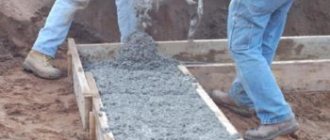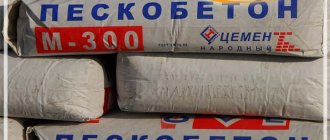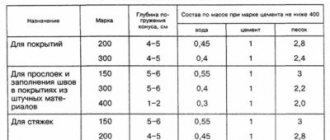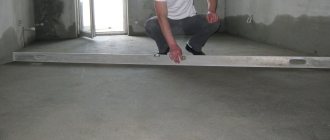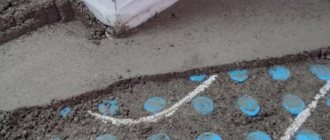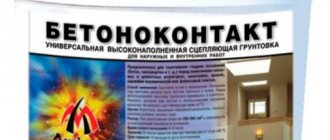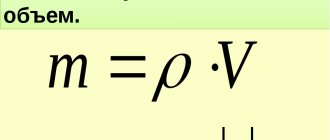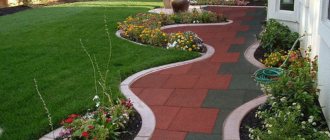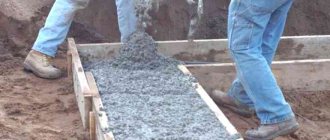Main settings
Sand concrete is a relatively new, but already extremely popular construction mixture, the M300 brand is especially popular. The increased interest in it is due to the fact that it can be used at almost all stages of construction work.
Scheme of the construction of a sand concrete wall.
Most often, sand concrete is used to form the floor, but it has also proven itself to be excellent in the construction of foundations (even on unstable soils), sealing joints and seams, brickwork and finishing work.
Even the pouring of reinforced concrete structures and assemblies is often carried out using this material. In addition, sand concrete grade M300 is considered the optimal construction mixture in terms of price-quality ratio.
Any craftsman immediately thinks: is it possible to make such a miracle with your own hands? Theoretically, there is nothing simpler. The main thing is to mix three main components: cement, sand and special additives (additives). Sand gives the material resistance to stress, and Portland cement gives it density, strength, corrosion resistance, frost resistance, etc. Additives enhance its individual qualities or impart new ones. However, the proportions, quality of ingredients and additives differ depending on the purpose for which the mixture needs to be made. For example, in order to make sand concrete that is as strong and resistant to external influences as possible, which is suitable for floor screed, it is necessary to use low-aluminate Portland cement.
Hydraulic concrete. Features of strengthening the floor slab from above. Aerated concrete blocks: pros and cons. More details>>
How many bags of sand concrete are in a cube?
The question of how many bags of sand concrete are in a cube cannot be called rhetorical. Every master who deals with major repairs, and even more so the construction of a residential building or service building, periodically encounters it.
What you need to know about sand concrete?
Sand concrete, which plays an important role at various stages of construction, is a basic mixture consisting of two essential components: first-grade Portland cement and mixed-grade sand with grains from 1.5 to 3 mm. Sometimes granite crushed into crumbs or powder and chemicals (plasticizers, modifiers, etc.) are also added to this mixture.
Its strength depends on the ratio of the two main components of a given composition; it is indicated by a digital indicator (m150, m200, m300, m400), and the number in the marking corresponds to the weight of the load, which can withstand one square centimeter of frozen mortar without breaking. Of all the varieties of this building material, M300 sand concrete is particularly widespread, which is characterized by an excellent ratio of high performance properties and affordable price. This composition is widely used by both professionals and amateur craftsmen, who are attracted by the ease of working with this composition and the guaranteed result.
Costs of sand concrete for floor screed
Sand-cement mixture is used for various types of external and internal construction work, such as concreting sites, sealing joints, etc. However, the calculation of how many bags of sand concrete in a cube is most often required to determine the amount of this material for floor screeding: As a rule, it is at this stage of repair that the greatest consumption of the composition occurs.
According to professionals, to produce a coating 1 cm thick on 1 square meter of subfloor requires 18-20 kilograms of sand concrete mixture. If we consider the estimated thickness of the screed to be 7 cm (in reality it can vary slightly), then 1 m2 will require approximately 140 kg of composition or almost three standard bags weighing 50 kg.
How many bags of sand concrete are in a cube: continue the calculations
Before continuing with mathematics and answering the question asked, it should be clarified that bags with this mixture can have different volumes. The standard packaging is 50 kilograms, but many manufacturers also produce sand concrete mixture packaged in packages weighing 15, 20, 25, 30 and 40 kg. It is more profitable to buy sand concrete in large bags, since in this case its cost is lower. However, experts do not advise doing this if the scale of work is small. Cement and compositions based on it have a certain shelf life, after which its properties drop sharply, so it is not advisable to buy them for future use. However, let's return to the calculations: based on the density of sand concrete, you can easily find out that in 1 cubic meter. meter contains 750 kg of dry mixture. From this we get the following: 1 m3 corresponds to 38 bags weighing 20 kilograms; 25 bags of 30 kg or 15 standard 50 kg packages.
How to save money when buying sand concrete?
As you can see, sand concrete is one of the most consumable materials during construction work, which means that its purchase is an important item in the budget. However, there is no need to rush to the market to buy the first cheap mixture you come across: this building material is often falsified. If you want to save money, order sand concrete in our online building materials store, where not only is there a good selection of similar mixtures in different packages, but also a quality guarantee is given for all products offered.
Return to list
www.stroika99.ru
Solution recipe
Scheme of temperature effects on sand concrete.
Each manufacturer of building mixtures tries to develop its own unique composition of sand concrete. And despite the small number of its components, their volumes, proportions, quality, as well as types of additives can significantly influence the properties of the final building mixture. Needless to say, it is possible to make sand concrete yourself, but it is very risky if you think about the quality. After all, even if you accurately check all the proportions, the sand may not be clean enough or the cement may be of poor quality, etc. It is also important to thoroughly mix all the components, otherwise, for example, you will not be able to create a smooth and durable floor filled with sand concrete. Nevertheless, many take risks, and quite successfully. So, let's take a look at what sand concrete consists of.
Today the construction industry includes at least 30 types of cement. Portland cement is most often used to make sand concrete. It consists of clinker and gypsum. To prepare it, clinker is crushed with the gradual addition of gypsum. In this case, it is necessary to ensure that the content of sulfur oxide in the mixture, which is part of the gypsum, is in the range of 1.5-3.5%. It is easy to calculate - in each percent of gypsum, sulfur oxide is 0.45%.
Areas of application of sand concrete
- Grades M 50 and M 100 are used for restoring old cement coatings and sealing shallow cracks. To perform small volumes of work, it is recommended to purchase bags weighing 25 kg.
- Dry mixtures of grade M 150 are used for preparing masonry mortar. Compared to a conventional cement-sand mixture, interblock joints made of sand concrete have increased strength and are almost 100% moisture-proof.
- A heated floor screed made of sand concrete grade M 200 can maintain the heating of the base for a long time.
- Sand concrete grade M 300 is a universal means for forming monolithic reinforced concrete structures. Wall panels are cast from it for external non-load-bearing fencing and internal partitions.
- Monolithic structures made of PB grades M 400 and M 500 can withstand heavy loads. Sand concrete floor slabs are used in the construction of multi-storey buildings and structures.
Mixing ingredients
So, we have all the components at hand, placed at floor level, all that remains is to mix them and dilute them with water. For this process you will need a minimum of tools:
- container for mixing dry mixture;
- container for diluting the mixture;
- measuring container (a bucket will do);
- shovel;
- drill with attachment or construction mixer.
Pour cement and sand into the mixing container in appropriate proportions and mix thoroughly with a mixer or simply with a shovel or stick until smooth. Next, as a rule, water is added - the mixture is simply diluted. Calculation – 1.5-1.8 liters per 10 kg of dry mixture. It is extremely important to maintain the accuracy of the proportions, since if there is too much water, the sand concrete will lose strength and quickly crack.
Water is poured into a separate container, where the mixture is gradually, stirring thoroughly, and then plasticizers are added. The resulting solution should stand for 5-10 minutes, after which it is mixed again with the same thoroughness. It must be used within 2 hours, otherwise it will harden and become unusable. Sand concrete grade M300 is applied in a layer of 10-50 mm. The maximum layer thickness for this brand of cement is 100 mm, but in this case the use of reinforcing mesh will be required.
How many bags of sand concrete are there in a cube?
- /
- How many bags of sand concrete are there in a cube?
In order to correctly calculate the required number of bags, you need to calculate how many bags of sand concrete are in a cube. As you know, 750 kg of sand concrete mixture is consumed per cubic meter. It is on this basis that the bags should be calculated. Thus, we get the following:
- If the bag is 20 kg, then you need 38 bags;
- If the bag is 30 kg, then you need 25 bags;
- If the bag is 50 kg, then you need 15 bags;
- If the bag is 100 kg, then you need 8 bags.
These are approximately the cost norms for different packaging of the material.
Packing sand concrete bags
Today you can buy sand concrete in paper bags of 20, 30, 50 and 100 kilograms. The most common bags are 30 and 50 kilograms. Experts recommend purchasing large-volume bags only if you have to complete a large amount of work in a short time. It is also worth noting that the larger the volume of the bag, the cheaper 1 kilogram of mixture costs you.
How to correctly calculate how many bags you need
For example, to fill a floor of 1 sq. m, with a layer thickness of 15 mm we will need about 18-20 kg of sand concrete.
A finished solution 1 meter thick will be calculated using the following formula:
1000 mm / 15 mm * 18 kg = 1200 kg of dry mixture.
Here 1000 mm is the thickness of the layer, and 15 mm * 18 kg is the weight of a layer with a thickness of 15 mm and an area of 1 sq.m.
How to calculate the consumption of sand concrete for a screed?
Given: an apartment with an area of 50 meters, the average layer thickness is 7 cm. To level the floor with a sand concrete screed per square meter, we need 20 kg. to a thickness of 1 cm of dry mixture.
Thus: 20 kg * 7cm = 140 kg of sand concrete we need for 1 meter. The area in the example is 50 meters. We multiply: 50 m² * 140 kg = 7000 kg - this will be the final consumption.
Accordingly, in bags:
- 100 kg - 70 bags,
- 50 kg - 140 bags,
- 40 kg - 175 bags,
- 30 kg - 234 bags,
- 20 kg - 350 bags.
smesinazakaz.ru
Material consumption for the foundation
When working with sand concrete, it is important to correctly calculate the material consumption. Its quantity is influenced by the area of work performed and instructions for use. M300 is considered a universal remedy. It is used in any construction work: monolith, foundation, plastering, etc.
We take into account the consumption per 1m3:
- for pouring, a cubic meter will require 1.50 - 1.70 tons of dry compound;
- approximately 30 bags weighing 50 kg will be needed;
- the total material consumption can be calculated by knowing the working area.
Return to contents
Composition and types of sand concrete M300
In accordance with the state standard, dry sand concrete mixture grade M300 includes Portland cement M300, dense river sand of fine (0.5 mm) and coarse fractions (no more than 3 mm) and a set of modifying additives. Among these, the mixture may contain plasticizers that reduce hardness and increase the frost resistance of the solution, anti-corrosion components, granot sieving, and sometimes small crushed stone. The indicator “300” in the marking of the material indicates its tensile strength, expressed in kg per 1 cm2 after final hardening (after 28-30 days).
Depending on the ratio of the components that make up the material and the fractionation of the filler, dry sand concrete M300 is divided into three types:
- fine-grained (0.5-2.0 mm), used for primary plastering of surfaces and sealing joints;
- medium fraction (2.0-2.2 mm), used for laying bricks, building blocks and paving slabs, forming screeds and poured floors;
- coarse-grained (2.2-3 mm), suitable for pouring shallow monolithic foundations and installing reinforced concrete structures.
The homogeneity and standardized composition of the initial mixture, as well as the plasticity of the diluted solution, ensure uniform filling of the cavities, eliminating its caking and undesirable concentration in certain areas of the working volume. The best adhesive qualities of the material are manifested when it is applied in a layer of 10 to 50 mm. If the thickness is greater, the setting period increases. In this case, be sure to use a masonry mesh. The certified setting time of M300 sand concrete (for a 10 mm layer), regardless of the type, is 120-180 minutes with the viability of a freshly prepared solution within 120 minutes. The mixture reaches its maximum strength 28 days after installation.
Number of bags of sand concrete mixture per cubic meter
When purchasing building materials, you are always interested in the question of how much is needed per 1 m3. Sand concrete in bags is one of the most common; it is used for the construction of buildings and structures at different stages of construction. The composition includes first grade cement, sand with fractions from 1.5 to 3 mm, plasticizers and chemical additives.
Application of sand concrete mixtures
In some cases, granite powder or frost-resistant fillers are added to improve technical properties. The ratio of components directly affects the quality, so there are several markings: M150, M200, M300, M400. The numbers show strength during operation. The M300 brand is considered the most popular, as it has high performance and a relatively reasonable price.
Today, sand concrete is produced in bags weighing 40 and 50 kg. To determine its capacity of 1 m3, a small calculation should be carried out. The weight of one cubic meter is about 2.3-2.4 tons, since it belongs to the group of heavy concrete. Consumption per 1 m2 is approximately 20 kg with a layer thickness of 1 cm. To find out how many bags of sand concrete weighing 40 kg are in a cube, you need to use the formula: 40 kg/20 kg = 2 cm; 100 cm/2 cm = 50 bags per 1 m3, where:
- 40 kg – bag weight;
- 20 kg – consumption per 1 m2;
- 100 cm is the thickness of the cube (1m*1m*1m=1 m3 - length*width*thickness).
With a weight of 50 kg, the result is directly proportional and will be 40 bags. It is first necessary to accurately assess the proportions, surface condition, as well as the thickness of the applied layer.
1. Weight of a cube of sand concrete.
To carry out calculations, the specific gravity of one cubic meter is used in the following units of measurement: 2.4 g/cm3, 2400 kg/m3 or 2.4 t/m³. To reduce consumption, it is recommended to use various additives. Often, granite chips or expanded clay are used for screeding in an amount of 60% of the total volume of the solution.
2. Capacity of cubes in a bag of dry mixture.
Since the volume of a bag of sand concrete is 40 kg, and the weight of a cubic meter of material is 2400 kg, then one container holds: 40 kg/2400 kg = 0.017 m3. Accordingly, the capacity with a bag weight of 50 kg will be equal to: 50 kg/2400 kg = 0.021 m3.
Often monolithic reinforced concrete structures are made from it. Also used for filling joints and seams. Due to their high performance qualities, the structures comply with all norms and standards, which is why they are often used in the construction of large-sized buildings and industrial complexes.
Sand concrete mortar for floor screed or plaster is universal, so it does not require the creation of certain conditions. It can be used for external and internal work.
Features and Benefits
Has technical characteristics:
- sand fraction – 1-5 mm;
- liquid consumption – 0.12-0.15 l per 1 kg of solution;
- mixture consumption – 20 kg per 1 m²;
- strength indicator 30 MPa (grade M300);
- complete hardening time - 4 weeks (under normal conditions and absence of precipitation);
- operating condition at temperatures up to +20°C – 2 hours.
- High-tech solution for pouring foundations.
- It is used for plastering walls and ceilings inside and outside buildings.
- Suitable for screeds, blind areas, self-leveling floors.
- Excellent grip on any surface.
- Easily processed and coated with various finishing materials.
- Able to provide the best conditions for creating design.
- Waterproof and frost-resistant – up to 70 cycles.
- Resistance to external factors, precipitation, mechanical loads.
- Ensures the intensity of construction work.
- Sufficient plasticity, with complete absence of shrinkage.
